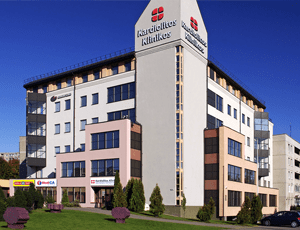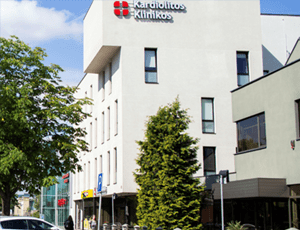The average cost of CABG - Redo in Vilnius approximately starts from USD 8000
Treatment cost

Kardiolita Hospital, Vilnius located in Vilnius, Lithuania is accredited by JCI. Also listed below are some of the most prominent infrastructural details:


Apart from in-detail treatment procedures available, Kardiolita Hospital, Kaunas located in Kaunas, Lithuania has a wide variety of facilities available for International Patients. Some of the facilities which are provided by them are Accommodation, Airport Transfer, Choice of Meals. Also listed below are some of the most prominent infrastructural details:
Awaxy called plaque hets deposited in good amounts in the coronary arteries of the heart, they supply oxygen to the heart. With time the plaque starts hardening and eventually ruptures and breaks open. This plaque interferes with blood flow as arteries grow narrow at that region. A blood clot develops when the plaque ruptures open on the surface. The artery gets blocked if the blood clot developed is very large. This can be the cause of heart attack in a later stage becoming the cause of a life risk.
Coronary artery bypass surgery aims at improving the general blood circulation to the heart. A healthy artery or vein is taken the body and is grafted or connected to the blocked coronary artery for bypassing. This artery or vein goes around the blocked portion of the coronary artery and establishes a new path for the blood to flow to the heart thus reducing the chance of a heart attack. In one surgery surgeons can bypass multiple coronary arteries. Severe blockages can be treated with this procedure.
The other alternatives for CABG can be balloon surgery or angioplasty which is a less invasive technique but then your cardiologist is the best person to decide which of the surgeries is best suited
The patients are transferred out of ICU right after the day of the surgery. Heart rhythm disturbances are found in 25% of patients within a period of 3 or 4 days after the surgery. They are temporary atrial fibrillations that are associated with surgical trauma. They respond well to standard
Ask your healthcare adviser for the best multiple options and choose the one that meets your expectations
In Vilnius, the average starting cost for CABG - Redo is $8000. CABG - Redo in Vilnius is conducted across several State Health Care Accreditation Agency (VASPVT) certified hospitals.
The cost of CABG - Redo in Vilnius may differ from one medical facility to the other. The top hospitals for CABG - Redo in Vilnius covers all the expenses related to the pre-surgery investigations of the candidate. The CABG - Redo cost in Vilnius includes the cost of anesthesia, medicines, hospitalization and the surgeon's fee. Extended hospital stay, complications after the surgery or new diagnosis may affect the overall cost of CABG - Redo in Vilnius.
There are many hospitals across the country that offer CABG - Redo to international patients. Some of the best hospitals for CABG - Redo in Vilniusinclude the following:
While the speed of recovery may vary from patient to patient, they are still required to stay for about 21 days after discharge. This time frame is important to ensure that the surgery was successful and the patient is fit to fly back.
Vilnius is undoubtedly one of the best cities for CABG - Redo in the world. It offers the best medical expertise and good patient experience at an affordable cost. Some of the other top destinations for CABG - Redo include the following:
There are certain expenses additional to the CABG - Redo cost that the patient may have to pay for. These charges may vary from 50 USD per person.
It is possible for patients to opt for video telemedicine consultation before they come for CABG - Redo in Vilnius. There are many kidney transpant surgeons who offer video telemedicine consultation, including the following:
Some of the most sought after doctors available for online video consultation for CABG - Redo in Vilnius are:
| Doctor Name | Cost | Book Appointment |
|---|---|---|
| Dr. Vaidotas Zabulis | 212 | Book Now |
| Dr. Rimantas Karalius | 315 | Book Now |
After CABG - Redo surgery, the patient is supposed to stay for about 7 Days in the hospital for recovery and monitoring. During the recovery, the patient is carefully monitored and control tests are performed to see that everything is okay. If required, physiotherapy sessions are also planned during recovery in hospital.
There are around 1 Hospitals hospitals in Vilnius that offer CABG - Redo to international patients. These hospitals have the required expertise as well as infrastructure available to handly patients who need CABG - Redo. Apart from good services, the hospitals are known to follow all standard and legal guidelines as dictated by the local medical affairs body or organization.
Some of the most sought after doctors for CABG - Redo in Vilnius are: